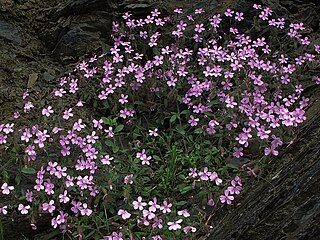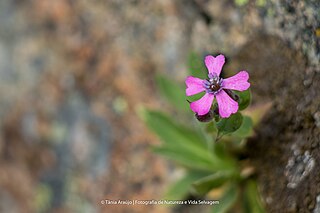
Caryophyllaceae, commonly called the pink family or carnation family, is a family of flowering plants. It is included in the dicotyledon order Caryophyllales in the APG III system, alongside 33 other families, including Amaranthaceae, Cactaceae, and Polygonaceae. It is a large family, with 81 genera and about 2,625 known species.

Schiedea verticillata, known as the Devils Slide schiedea or Nihoa carnation, is an endangered species of plant in the family Caryophyllaceae, endemic to the island of Nihoa in the Northwestern Hawaiian Islands, where it was discovered in 1923 by the Tanager Expedition. It has been listed as endangered since 1996.

Schiedea adamantis, commonly known as Diamond Head schiedea, is a species of flowering plant in the family Caryophyllaceae, that is endemic to the island of Oʻahu in Hawaii. It inhabits low shrublands on steep slopes along the northwest rim of Diamond Head Crater. Associated plants include nehe, kāwelu, ʻakoko, and ʻilima. There are only about 30 individuals remaining, and they are threatened by habitat loss.

Schiedea is a genus of flowering plants in the family Caryophyllaceae. It contains 34 species and is endemic to Hawaii.

Gynodioecy is a rare breeding system that is found in certain flowering plant species in which female and hermaphroditic plants coexist within a population. Gynodioecy is the evolutionary intermediate between hermaphroditism and dioecy.
Schiedea apokremnos is a rare species of flowering plant in the family Caryophyllaceae known by the common names Kauai schiedea, Na Pali Coast schiedea, and ma`oli`oli. It is endemic to Hawaii, where it is known only from the island of Kauai. It is threatened by the degradation of its habitat. It is a federally listed endangered species of the United States.
Schiedea attenuata is a rare species of flowering plant in the family Caryophyllaceae known by the common name Kalalau schiedea. It is endemic to Hawaii, where it is known only from the Kalalau Valley on the island of Kauai. It is threatened by the degradation of its habitat. It was federally listed as an endangered species of the United States in 2010.

Schiedea haleakalensis is a rare species of flowering plant in the family Caryophyllaceae known by the common name Haleakalā schiedea. It is endemic to Hawaii, where it is known only from Haleakalā National Park on the island of Maui. It is threatened by the degradation of its habitat. It was federally listed as an endangered species of the United States in 1992. Its native habitat includes dry subalpine cliffs with native shrubs.
Schiedea helleri is a rare species of flowering plant in the family Caryophyllaceae known by the common names Heller's schiedea and Kaholuamanu schiedea. It is endemic to Hawaii, where it is known only from the island of Kauai. It is threatened by the degradation of its habitat. It was federally listed as an endangered species of the United States in 1996.
Schiedea kauaiensis is a rare species of flowering plant in the family Caryophyllaceae known by the common name Kauai schiedea. It is endemic to Hawaii, where it is known only from the island of Kauai. It is threatened by the degradation and destruction of its habitat. It was federally listed as an endangered species of the United States in 1996.
Schiedea kealiae is a rare species of flowering plant in the family Caryophyllaceae known by the common name Waianae Range schiedea. It is endemic to Hawaii, where it is known only from the Waianae Range on the island of Oahu. It is threatened by the degradation and destruction of its habitat. It was federally listed as an endangered species of the United States in 1996.
Schiedea membranacea is a rare species of flowering plant in the family Caryophyllaceae known by the common name valley schiedea. It is endemic to Hawaii, where it is known only from the island of Oahu. It has been extirpated from Maui and Molokai. Plants in a population known from Kauai are actually members of other species. Thus, the species is now endemic to Oahu. It is threatened by the degradation and destruction of its habitat. It is a federally listed endangered species of the United States.
Schiedea sarmentosa is a rare species of flowering plant in the family Caryophyllaceae known by the common name cliff schiedea. It is endemic to Hawaii, where it is known only from the island of Molokai. It is threatened by the degradation and destruction of its habitat. It is a federally listed endangered species of the United States.
Schiedea spergulina is a rare species of flowering plant in the family Caryophyllaceae known by the common name canyon schiedea and spreading schiedea. It is endemic to Hawaii, where it is known only from the island of Kauai. It is threatened by the degradation and destruction of its habitat. There are two varieties of this plant, one federally listed as an endangered species of the United States, and the other listed threatened.
Schiedea stellarioides is a rare species of flowering plant in the family Caryophyllaceae known by the common name lau lihilihi. It is endemic to Hawaii, where it is known only from the island of Kauai. It is threatened by the degradation and destruction of its habitat. The plant is federally listed as an endangered species of the United States.

Silene alexandri is a rare species of flowering plant in the family Caryophyllaceae known by the common names Kamalo Gulch catchfly and Alexander's catchfly. It is endemic to Hawaii, where it is known only from the island of Molokai. It is threatened by the degradation of its habitat and it is a federally listed endangered species of the United States.

Silene lanceolata is a rare species of flowering plant in the family Caryophyllaceae known by the common names Kauai catchfly and lanceolate catchfly. It is endemic to Hawaii, where it is known only from Oahu, Molokai, and Hawaii, having been extirpated from Kauai and Lanai. It is threatened by the degradation of its habitat and it is a federally listed endangered species of the United States.

Petrocoptis pseudoviscosa, commonly known as falguera, is a species of plant in the family Caryophyllaceae. It is endemic to the Spanish province of Huesca, where it is only known from the Valle del Ésera in the Pyrenees. Its natural habitat is calcareous cliffs, crags and caves.
Ann Kiku Sakai is a plant biologist at the University of California, Irvine known for her work on plant breeding and speciation. She is an elected fellow of the American Association for the Advancement of Science.

Silene acutifolia is a species of herb native to northwest Spain as well as central and northern Portugal. The species is polycarpic and usually grows in rocky environments.










